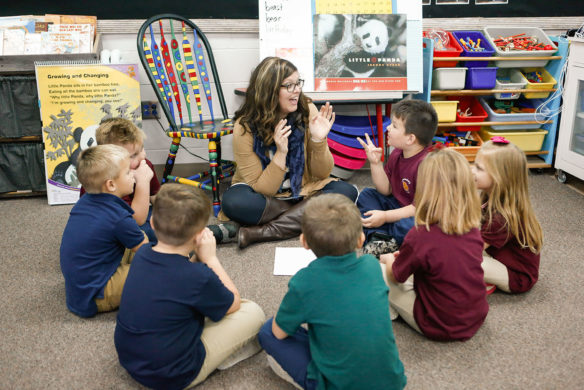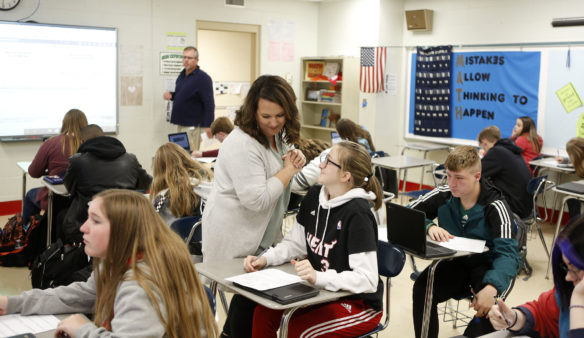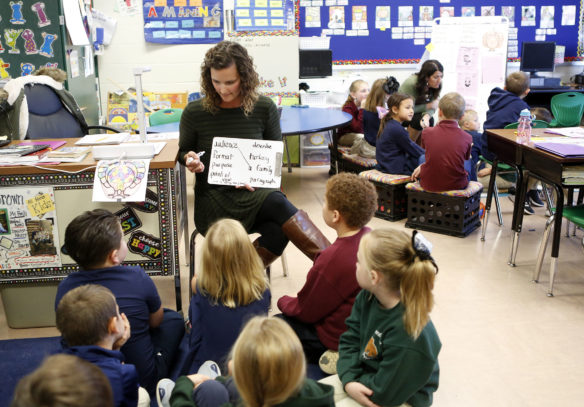
Kindergarten teacher Erin Donnerman works with a group of students during a class at Brandenburg Primary School (Meade County). The number of students scoring at the novice level in all Meade County elementary schools has fallen since the district began an overhaul of its special education structure in 2014.
Photo by Mike Marsee, Nov. 12, 2019
- The district is about halfway through a 10-year plan that has seen a reduction in novice numbers for elementary school and middle school students.
- Hundreds of visitors from more than 30 other districts, educational cooperatives and the Kentucky Department of Education have come to Meade County to see its model in action.
By Mike Marsee
mike.marsee@education.ky.gov
Meade County has found the keys to improving special education services for its schools, and the district is willing to share them with anyone who wants to take its system for a test drive.
The district has enjoyed success in novice reduction at all school levels since it began an overhaul of its special education structure in 2014. District officials are anxious to share their efforts with educators from across the state who are working to making improvements in the delivery of special education services in their schools.
“The model that we’ve taken for special education is the model that’s best for all kids,” said Mark Martin, who joined Meade County schools as director of special education in 2014. “This is about college and career readiness, because every kid deserves a life even if they don’t have that test score.”
Meade County’s model puts an emphasis on a shared learning space, with the use of supplemental resource designed to support students with special needs.
The schedule is intended to promote an inclusive culture and close achievement gaps by emphasizing instruction for all students.
“If you want your test scores to go up, you have to include all kids,” Meade County Superintendent John Millay said. “Special education has to be part of regular education. That has to be a philosophy from the top down.”
Since changes began at Meade County, novice numbers for special education students have been shrinking at the elementary and middle school levels:
- In the 2013-2014 school year, 38.1% of elementary school students with disabilities scored at the novice level in reading and 36.1% did so in mathematics on K-PREP assessments. In 2018-2019, the novice numbers were 30.6% in reading and 28.8% in math.
- In 2013-2014, 51.4% of middle school students with disabilities scored at the novice level in reading and 38.5% did so in mathematics. In 2018-2019, the novice numbers were 44% in reading and 25.9% in math.
However, novice numbers at Meade County High School have fluctuated during the same time, and a significant achievement gap between students with disabilities and non-disabled students was identified in the 2018-2019 accountability data. Martin said one of the primary goals for the second phase of the district’s plan is to implement instructional supports to reduce novice numbers at its middle school and high school.
Martin said he is convinced that will happen.
“This is a 10-year plan, and we’ve got about four or five more years to get the middle school and the high school looking like the elementaries,” he said.
At its heart, the Meade County system encourages educators to take risks.
“We take risks from the top,” Martin said. “We have to model that for our principals so they can model that for our co-teaching teams. It’s OK to take chances. If it doesn’t work, that’s all right. We’ll come back to the drawing board and try to figure it out.”

Mathematics teacher Ellen Hall, front, and special education teacher Kevin Robinson, back, work with separate groups of students in parallel teaching during a math class at Meade County High School. Parallel teaching is one method of co-teaching used in the Meade County schools’ special education model.
Photo by Mike Marsee, Nov. 12, 2019
At the student level, there is an emphasis on what Martin calls “productive struggle.”
“Students need to productively struggle,” he said. “It’s OK if they struggle, because if they don’t, if we just protect them from preschool on, they’re not going to be college and career ready. They’re not going to be able to persevere when things get difficult.”
Meade County’s model, which received a best practice award from the Kentucky Department of Education in 2019, is based on five keys:
- A districtwide buy-in that begins at the highest levels of administration and is conveyed to principals, staff members, parents and students.
- Instructional focus that does not merely emphasize compliance.
- Identification of the barriers that stand between students and college and career readiness and finding ways to overcome them.
- The restructuring of scheduling around a co-teaching structure that better utilizes personnel and making the best use of available funds to do that.
- The elimination of outside “noise” by maintaining a focus on moving the needle for all students.
Co-teaching and supplemental resource are the key, but those things don’t look the same across the district.
Co-teaching takes place either through the use of station teaching, in which students are divided into groups and teachers focus on one section of content within those groups, or parallel teaching, in which the class is divided into two groups and two teachers cover the same content simultaneously. The district uses a co-teaching cadre through which teachers receive ongoing professional learning and information on best practices and co-teaching strategies.
“We empower our principals and teachers to find the co-teaching strategy that works for them as long as it engages all students and the structure is quality,” Martin said. “Providing autonomy to our staff is crucial in sustaining a strong culture and balanced continuum.”

Resource teacher Erin Whitt, front, and 2nd-grade teacher Jenna Brown, back, work with separate groups of students in station teaching during a class at Brandenburg Primary School (Meade County). Station teaching is one method of co-teaching used in the Meade County schools’ special education model.
Photo by Mike Marsee, Nov. 12, 2019
There is an intentional use of personnel with an eye toward students’ specific needs. For example, three special education teachers at both Flaherty Primary School and Flaherty Elementary School share their work in the same room. Martin said effective scheduling of personnel better helps them meet students where they are.
“Our teachers work very closely together, and our special education teachers feel empowered by their instructional first attitude,” Martin said. “They have changed their habits and are closing gaps on a daily basis.
“All students are regular education first, and all influential stakeholders need to work together to ensure this is truly being practiced each day.”
There are other approaches as well, including the use of the PASS (Positive Approach to Student Success) program for students with behavior issues. There are social skills instruction and the use of student engagement to combat behavioral issues, a new inclusive playground at one of the district’s elementary schools, sensory rooms and a speech team.
In addition, an annual district-led professional development program held just before the start of the school year that began as a way to bring co-teaching teams together has grown into a popular event that serves all of the district’s teachers.
“This is more than a special education story,” Martin said. “You must first have a strong culture, instructional core, PBIS (Positive Behavioral Interventions and Supports) and district professional learning community in place to be positioned for success in special education.”
Meade County also is collaborating with the University of Louisville’s Center for Instructional and Behavioral Research in Schools and director Terry Scott, who is working with the district to support it schools. In addition, author John O’Connor, a nationally recognized special education expert, has asked the district to contribute a section to his next book.
There has been plenty of interest from outside the district as well. Meade County has hosted hundreds of visitors from more than 30 other districts as well as staff members from educational cooperatives, and the district will host another 340 visitors this spring. It had previously filled all of its scheduled dates for the spring but recently added an additional date.
Visitors are shown classrooms and facilities at several schools. Martin tells them that he believes the Meade County model can work for both rural and urban districts.
“It takes struggling schools and improves (them, and) it takes good schools and takes them from good to great,” Martin said. “It gives you that little bit extra. There’s always that little bit of a gap that needs to be mitigated.”
MORE INFO …
Mark Martin mark.martin@meade.kyschools.us
John Millay john.millay@meade.kyschools.us




Leave A Comment